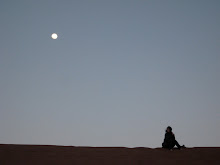“I know New Yorkers hate audience interaction,” Jeremy Wade said half apologetically to his small audience before instructing us to get up out of our chairs and engage in a bit of partner-focused aura cleansing. This New Yorker, for one, sure did hate it—all that forced touching and obligatory interaction with strangers. I appreciate, however, how it set the scene for the rest of the performance by emphasizing the communal experience. Wade and musician Pete Drungle, accompanied by percussionist Mike Skinner, used movement, text, sound, music, and a spinning disco ball to whirl the audience with them into a psychedelic vortex of energy and memory.
Although the performers’ respective strengths showed most clearly through music and movement, in this work-in-progress called The Whirling Visitation there ends up being very little distinction between spoken word and gesture. Wade’s jerky gesticulations—as if each movement were halted before completion—seem to originate from all points in his body at once. From Wade’s tongue to his eyebrows and fingertips, his body becomes a container for the same kind of human energy we cleansed in our partners at the beginning of the show. Physicality, in this case, extends to voice as well: singing and spoken word are seamlessly integrated as actions also originating from energy held in the body. Despite this successful continuity, the show would benefit from slimming down the volume of spoken text, which was appropriated in collaboration with Marcos Rosales. A newer investigation for Wade, the text isn’t yet as masterfully integrated as Drungle’s strange and beautiful electronic auditory elements.
Most of the time it looks as if there is something pulsing through Wade and trying to get out—that’s where the text-based drug references make their most complimentary impact. He holds a lighter in between his teeth as he reads from the classic teenage addiction memoir Go Ask Alice or reworked sections from J.T. Leroy’s The Heart is Deceitful Above All Things. While reading, he steps gently from one foot to the other and shakes his fingers to indicate them as the outermost physical limits of his contained internal electricity. Wade and Drungle use guided visualizations and the concepts of alien visitations and psychedelic oblivion in this piece, not only as aesthetic references, but also to try and draw elements of the ecstatic experience into the realm of performance.
The rave culture that Wade is associated with (and to some degree all club dancing) engages movement in its primitive, experiential form: here, the ecstatic trance is visually interpreted. The performers obviously aim beyond metaphor and toward the sublime experience. However, despite audience participation and Wade’s substantial charisma, the work never quite inhabits the space between art and ecstasy. A satisfying interdisciplinary dance piece, it steps right up to the edge of something more.
Link to article HERE
